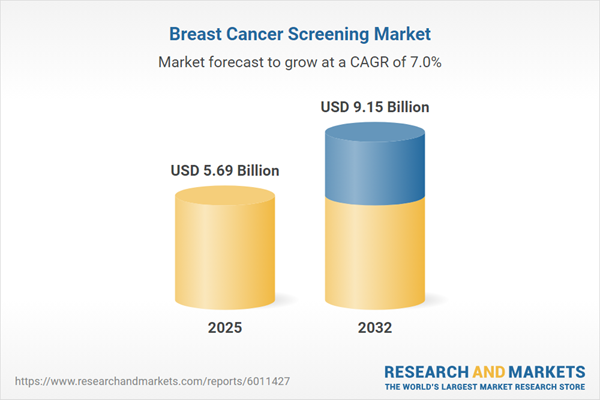Speak directly to the analyst to clarify any post sales queries you may have.
The breast cancer screening market is experiencing dynamic shifts as technology, policy, and patient engagement models evolve, redefining both detection processes and clinical management. Senior decision-makers in healthcare and medtech can leverage these developments to optimize resources, elevate patient outcomes, and enhance competitiveness in a rapidly transforming landscape.
Market Snapshot: Breast Cancer Screening Market
The breast cancer screening market grew from USD 5.31 billion in 2024 to USD 5.69 billion in 2025. With an anticipated compound annual growth rate (CAGR) of 7.03%, it is forecast to reach USD 9.15 billion by 2032. Sustained market expansion is underpinned by rising awareness, ongoing innovations in imaging, and robust investments from providers and technology manufacturers worldwide.
Scope & Segmentation of the Breast Cancer Screening Market
This report delivers comprehensive insights into technologies, patient profiles, delivery models, and geographies, supporting tailored strategy for stakeholders.
- Technologies & Modalities: 2D Mammography (Analog, Digital), 3D Tomosynthesis, Magnetic Resonance Imaging (Contrast Enhanced, Non Contrast), Molecular Breast Imaging (Breast Specific Gamma Imaging, Scintimammography), Thermography, Ultrasound (Automated, Handheld)
- Age Groups: 40 to 49, 50 to 69, 70 and above, Under 40
- Delivery Modes: Cloud (Software as a Service, Web Based), On Premise
- End Users: Ambulatory Care Centers, Clinics (Primary Care, Specialty Clinics), Diagnostic Centers (Chain, Independent), Hospitals (Private, Public)
- Regions Covered: Americas (North America: United States, Canada, Mexico; Latin America: Brazil, Argentina, Chile, Colombia, Peru), Europe, Middle East & Africa (Europe: United Kingdom, Germany, France, Russia, Italy, Spain, Netherlands, Sweden, Poland, Switzerland; Middle East: United Arab Emirates, Saudi Arabia, Qatar, Turkey, Israel; Africa: South Africa, Nigeria, Egypt, Kenya), Asia-Pacific (China, India, Japan, Australia, South Korea, Indonesia, Thailand, Malaysia, Singapore, Taiwan)
- Notable Market Players: Hologic Inc., GE HealthCare, Siemens Healthineers AG, Koninklijke Philips N.V., Fujifilm Holdings Corporation, Canon Medical Systems Corporation, Konica Minolta Inc., Shimadzu Corporation, Shenzhen Mindray Bio-Medical Electronics Co., Ltd., Carestream Health Inc.
Key Takeaways for Senior Decision-Makers
- Artificial intelligence is shaping workflows by supporting radiologists in earlier and more precise lesion identification, enabling improved patient risk management and reducing diagnostic workloads.
- Regulatory shifts allow streamlined access to advanced modalities, while new patient engagement tools, such as teleconsultation and mobile apps, reduce screening disparities in underserved areas.
- Healthcare organizations are adopting cloud solutions for image sharing and remote collaboration, while simultaneously maintaining on-premise systems for data security and integration with legacy infrastructure.
- Financial and procurement models are evolving, with providers turning to usage-based billing, equipment-as-a-service agreements, and bundled offerings to preserve flexibility amidst rising supply chain costs.
- Regional differences in technology adoption reflect unique funding frameworks, infrastructure maturity, and public health strategies, necessitating locally informed go-to-market approaches for both OEMs and service providers.
Tariff Impact on Market Dynamics
Recent tariff measures in the United States have increased the cost of imaging equipment by affecting import duties on key components. Manufacturers responded by sourcing locally, strengthening domestic partnerships, and investing in US-based facilities. This, in turn, has prompted healthcare buyers to negotiate longer-term service contracts and embrace flexible financing structures to manage budgetary uncertainty and ensure access to updated screening technologies.
Methodology & Data Sources
Insights are driven by a hybrid approach combining primary stakeholder interviews with radiologists, administrators, and technology suppliers, alongside secondary analysis of peer-reviewed publications, regulatory filings, and industry databases. Market segmentation and supply chain implications are validated through cross-referencing and expert reviews, providing transparent and evidence-based recommendations.
Why This Report Matters for Decision-Makers
- Enables executive teams to align investments with technology trends and evolving regulatory demands across global markets.
- Equips commercial leaders to fine-tune product portfolios and business models, responding to both macroeconomic risks and local opportunities.
- Supports strategic planning, procurement, and partnership decisions for enhanced screening execution and sustained growth.
Conclusion
The breast cancer screening market stands at the intersection of rapid technological advancement and shifting care paradigms. Stakeholders equipped with in-depth, actionable intelligence will be best positioned to drive innovation, access emerging markets, and contribute to improved patient screening outcomes.
Additional Product Information:
- Purchase of this report includes 1 year online access with quarterly updates.
- This report can be updated on request. Please contact our Customer Experience team using the Ask a Question widget on our website.
Table of Contents
3. Executive Summary
4. Market Overview
7. Cumulative Impact of Artificial Intelligence 2025
Companies Mentioned
The companies profiled in this Breast Cancer Screening market report include:- Hologic, Inc.
- GE HealthCare
- Siemens Healthineers AG
- Koninklijke Philips N.V.
- Fujifilm Holdings Corporation
- Canon Medical Systems Corporation
- Konica Minolta, Inc.
- Shimadzu Corporation
- Shenzhen Mindray Bio-Medical Electronics Co., Ltd.
- Carestream Health, Inc.
Table Information
| Report Attribute | Details |
|---|---|
| No. of Pages | 182 |
| Published | October 2025 |
| Forecast Period | 2025 - 2032 |
| Estimated Market Value ( USD | $ 5.69 Billion |
| Forecasted Market Value ( USD | $ 9.15 Billion |
| Compound Annual Growth Rate | 7.0% |
| Regions Covered | Global |
| No. of Companies Mentioned | 11 |









